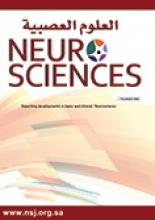To the Editor
We read the recent findings by Fil-Balkan et al,1 with great interest. Multiple neuropsychological assessment tools have been utilised in patients with Parkinson’s disease to evaluate sensorimotor integration at various levels. The Symbol-Digit modalities test (SDMT) is a neuropsychological assessment tool that has been utilised to examine cognition in several neurological disorders (including stroke, multiple sclerosis and Parkinson’s disease). A practice effect (namely, score improvement upon test re-administration) for SDMT has been described in the literature.2 The exact mechanism of such observed improvement has not been explicitly explored in the past. Incidental learning refers to the non-intentional memory of information that subjects are not asked to recall.3 In healthy adults, the contribution of incidental learning performance on the SDMT has been modest (and secondary to processing speed).4 In patients with multiple sclerosis, incidental learning was found to have minimal impact on the patients’ performance on the SDMT within the allotted 90 seconds.3 We sought to explore if the technique by which Parkinson’s disease (PD) patients complete the SDMT, as evidence by concomitant examination of eye movements, underlies the observed practice effect.
We recently recruited patients with PD as well as healthy controls as part of a larger study.5 In brief, 11 patients with PD and mild cognitive impairment (PD-MCI), 13 PD patients with normal cognition (PD-N) and 13 healthy controls (NC), matched for age, gender and education, were recruited. There was no statistically significant differences in the Unified Parkinson’s Disease Rating Scale (UPDRS) scores or modified Hoehn and Yahr scale among the PD participants. Participants were administered a battery of neuropsychological assessments, including the SDMT. Participants had continuous recording of eye-movements during performances of such assessments. The number and durations of fixations on the key and working areas of the SDMT were recorded during task performance.
To examine a practice effect, the SDMT task was administered to participants twice (referred to here as SDMT1 and SDMT2) with an interim period (of 15-20 minutes) in-between; participants were made to engage in other neuropsychological tasks in the intervening period in order to avoid mental rehearsal of the SDMT.
Demographic and clinical data of the participants have been described elsewhere.5 Significant mean score improvements between the 2 SDMT trials were observed in all groups: NC (+7 points; t12= -5.2, p<0.001), PD-N (+9.8 points; t11= -5.1, p=0.001) and PD-MCI (+8.9 points; t9= -4.5, p=0.017).
Practice effect on the SDMT, as assessed by an increase in the trial-score, was noted on the SDMT2 in participants from all study groups. With the novel task design (namely, employing eye movement tracking), we propose an explanation underlying this improvement. We posit that the key is used as ‘external memory’ during the SDMT. Rather than expending cognitive energy on learning the symbol-digit pairs, participants appear to utilise their ability to use rapid eye movements to seek information. We speculate that upon task repetition, participants’ fixations within the key area became more efficient (namely, faster to locate symbols within the key), potentially leading to faster completion of task rows with negligible effect on accuracy.
Our findings fit in part with findings by Denney et al,3 on a computerised version of the SDMT. While incidental memory could be employed to learn symbol-digit pairs during the test, the time-constrained nature of the test could lead the participant to favour fast saccadic eye movements to the key area as the optimal strategy. Owing to the speculative nature of our findings, it is difficult to ascertain whether this strategy persists as cognitive deterioration progresses in PD patients (namely, PD with dementia). Therefore, further research remains to be explored.
Reply from the Author
No reply received from the author.
Withdrawal policy
By submission, the author grants the journal right of first publication. Therefore, the journal discourages unethical withdrawal of manuscript from the publication process after peer review. The corresponding author should send a formal request signed by all co-authors stating the reason for withdrawing the manuscript. Withdrawal of manuscript is only considered valid when the editor accepts, or approves the reason to withdraw the manuscript from publication. Subsequently, the author must receive a confirmation from the editorial office. Only at that stage, authors are free to submit the manuscript elsewhere.
No response from the authors to all journal communication after review and acceptance is also considered unethical withdrawal. Withdrawn manuscripts noted to have already been submitted or published in another journal will be subjected to sanctions in accordance with the journal policy. The journal will take disciplinary measures for unacceptable withdrawal of manuscripts. An embargo of 5 years will be enforced for the author and their co-authors, and their institute will be notified of this action.
- Copyright: © Neurosciences
Neurosciences is an Open Access journal and articles published are distributed under the terms of the Creative Commons Attribution-NonCommercial License (CC BY-NC). Readers may copy, distribute, and display the work for non-commercial purposes with the proper citation of the original work.






